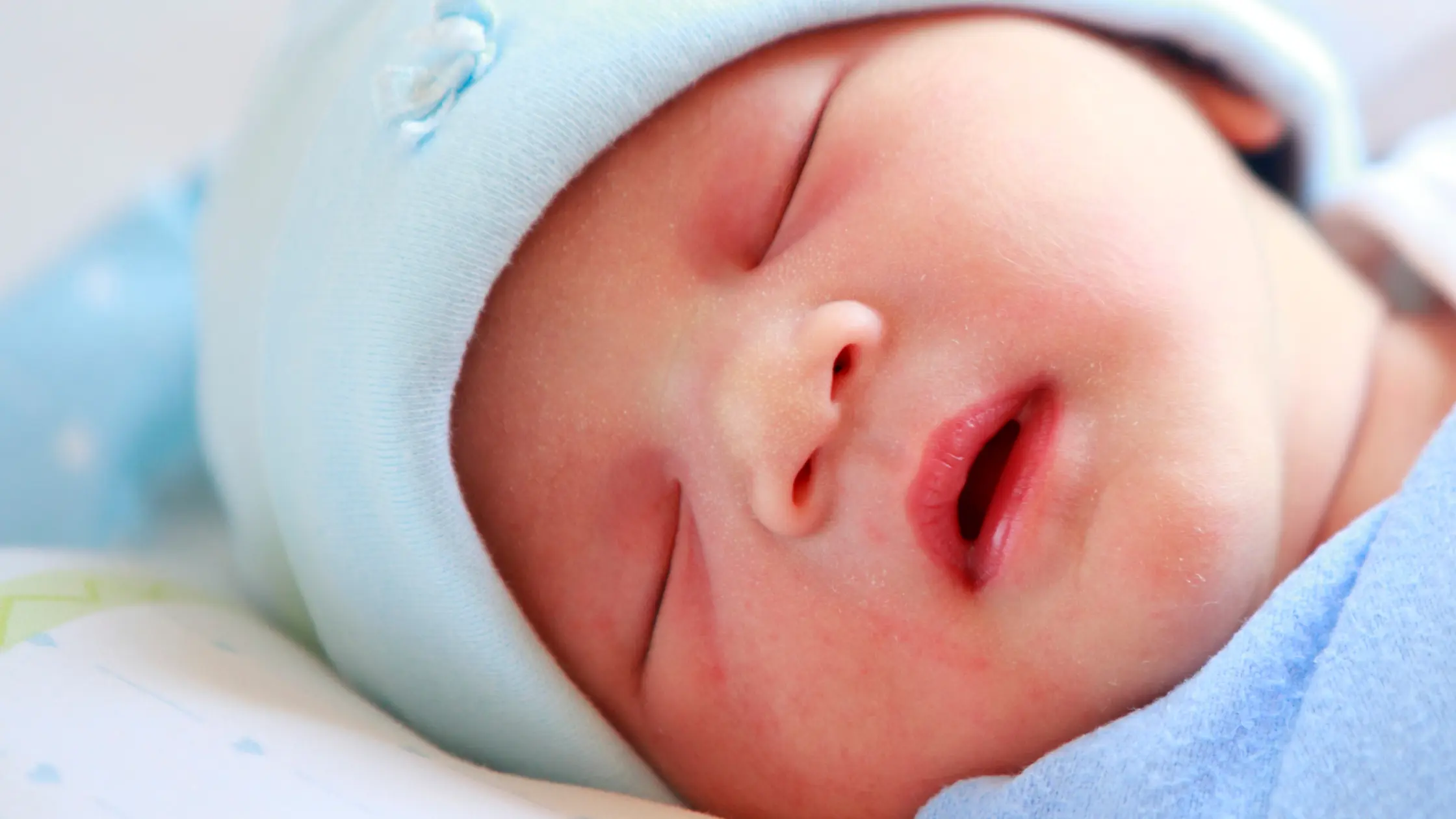When it comes to nose shapes in babies, every little nose is unique, just like the rest of their features. Parents usually ask whether the noses of their babies are shaped a certain way or are of a defective nature. Genetics and individual development (growth), as well as how the baby was lying in the belly, can have an impact on the shape of his or her nose in this comprehensive guide, we will explore the most common nose shapes, how to identify potential defects, and what steps you can take to correct any issues—whether naturally occurring or due to external factors.
Table of Contents
Understanding Different Nose Shapes in Babies
Babies have a variety of nose shapes, some of which are more prevalent than others. Babies nose shapes changes as they get older, so it’s critical for parents to monitor their child’s growth. While some noses, like the Roman nose shape, have a more noticeable curve, others may look adorable and button-like.
Types of Nose Shapes
Similar to adult noses, babies’ noses can have a range of shapes. By understanding these various kinds, parents can keep an eye on their child’s growth and identify potential issues. The following are some typical nose shapes:
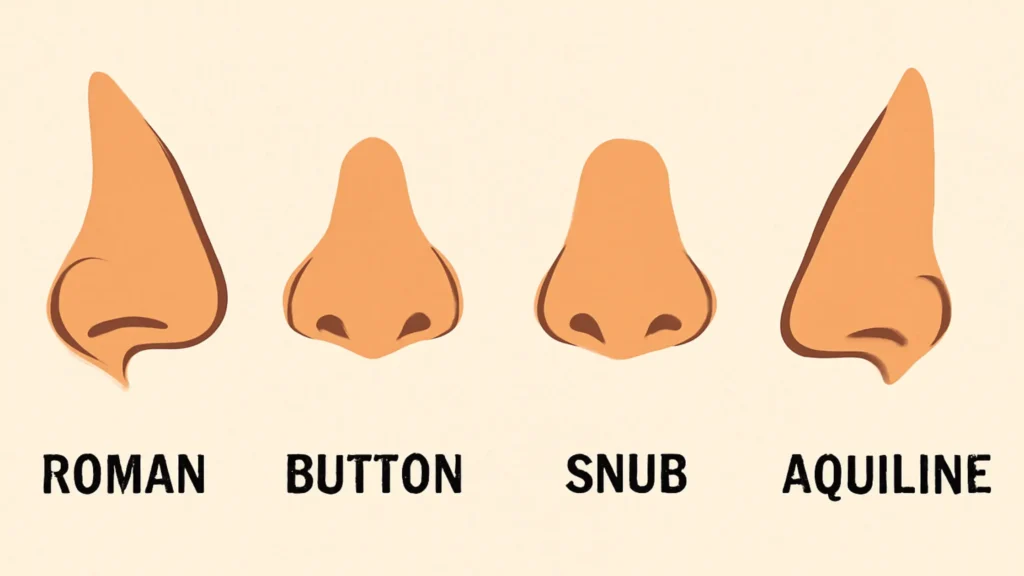
Roman Nose Shape
This type is distinguished by a slight bump in the bridge, making it appear more prominent. It may look sharp in profile, and the bridge of the nose may be higher than the rest, lending a regal feature to the face. It is associated with strength, contributing to a well-defined profile.
Button Nose Shape
The button nose shape is one of the cutest and most recognizable noses in babies. It is small, round, and slightly upturned at the tip, giving the baby a sweet, angelic look. This shape is admired for its youthful appearance, making it a universally beloved trait. It’s associated with innocence.
Snub Nose Shape
A snub nose shape is short and flat, with a small nostril opening and a flat bridge. It can sometimes appear slightly upturned but remains compact. Despite its shortness, the snub nose contributes to a cute, endearing look, giving a sense of balance to the face. Babies with this shape have a soft appearance.
Aquiline Nose Shape
Often referred to as the “eagle nose,” the aquiline nose shape is characterized by a prominent, curved bridge. It gives the face a more dramatic appearance, making it one of the more distinguished types. The aquiline nose shape adds strength, highlighting facial features in a bold manner. It is associated with wisdom.
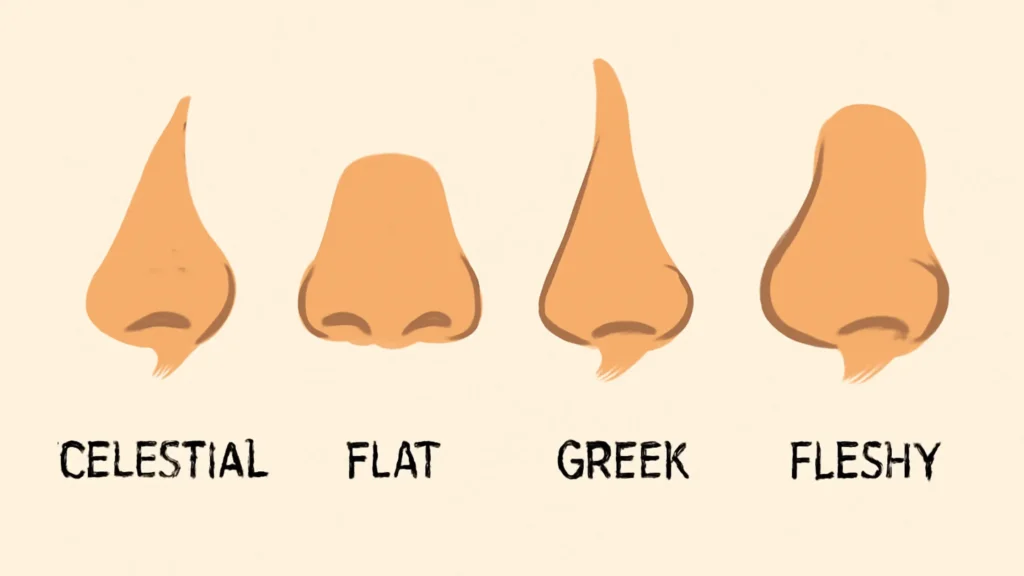
Celestial Nose Shape
A celestial nose shape is characterized by a short, slightly turned-up tip, often associated with a youthful appearance. It is similar to the button nose shape, but with a more pronounced upward curve, giving it a distinctive, charming look. The celestial nose shape evokes images of lightness, making it a popular trait.
Flat Nose Shape
A flat nose shape is typically seen in babies of Asian or Native American descent. It features a shorter, broader bridge, making it appear flatter. This type of nose appears more compact and is common for many babies. The flat nose shape exudes warmth and kindness, offering a softer look.
Greek Nose Shape
Greek noses are straight, narrow, and proportionate, with no visible bumps or curves. They are often regarded as the ideal shape because of their symmetry and elegance, and babies with this shape tend to have a balanced structure that makes them visually appealing. This type is admired for its timeless appeal.
Fleshy Nose Shape
A fleshy nose shape is characterized by a broad, rounded tip and soft skin; it is usually more noticeable in babies with a prominent nasal bridge or higher fullness. The fleshy nose shape gives the face a warmer appearance, lending a sense of youthfulness and approachability.
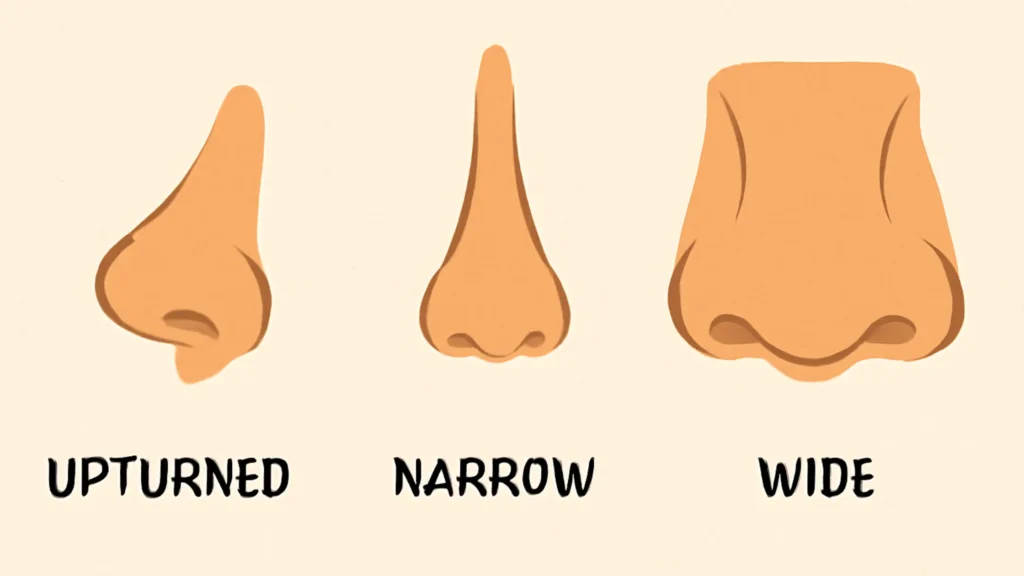
Upturned Nose Shape
The upturned nose shape is a cute feature where the tip of the nose points slightly upwards. It is often seen in babies with a button nose shape, but it can also be a distinctive feature of other shapes. This shape is associated with an optimistic personality, adding a playful look.
Narrow Nose Shape
Smaller nostrils and a tight, thin bridge define a narrow nose shape. It is frequently inherited from one or both parents and can give the nose a sophisticated, delicate appearance. Features appear more sculpted due to the narrow nose shape, which improves facial balance. It conveys an air of refinement.
Wide Nose Shape
The bridge and nostrils of babies with a wide nose shape may be wider. In some ethnic groups, this is typical and regarded as a sign of strength or individuality. A bold presence is provided by the wide nose shape, which also improves facial symmetry. It conveys fortitude, self-assurance, and uniqueness.
How to Identify Nose Defects in Babies
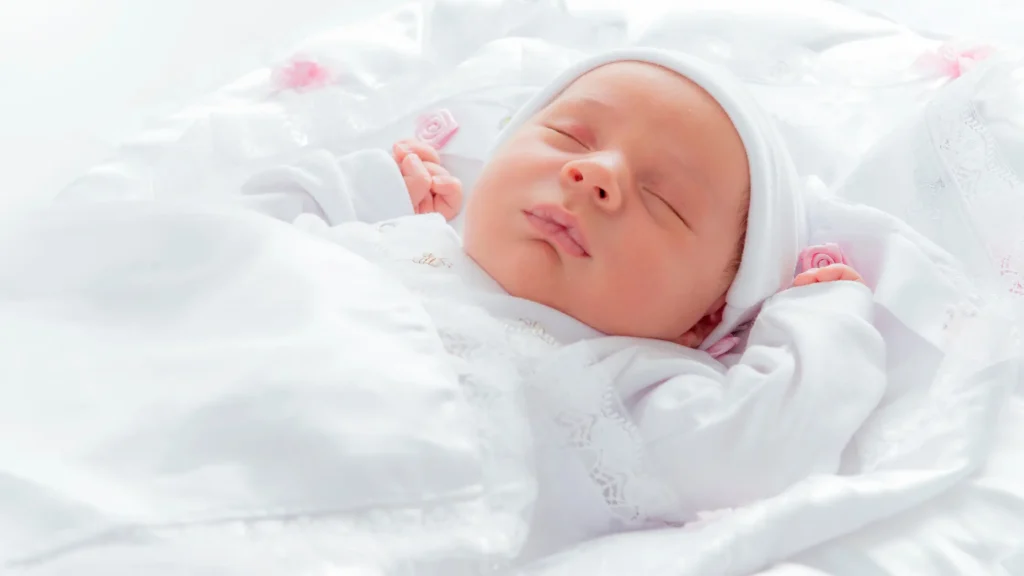
Babies frequently have a wide range of nose shapes, but occasionally, there may be flaws or irregularities. These flaws could be brought on by injuries, birth defects, or genetics. Early detection of these flaws can assist parents in getting their infants the care or treatment they require. When evaluating a baby’s nose shape, keep an eye out for the following indicators:
Signs of a Potential Defect
Asymmetry
Asymmetry. If the nose shape is distinctly asymmetrical or uneven, something might be wrong. One nostril being bigger than the other, for example, could indicate developmental problems. Uneven cartilage growth can cause asymmetry, which can affect nasal structure and breathing. A medical evaluation is advised to ascertain whether treatment is required.
Bumps or Irregularities on the Nose Bridge
A Roman nose shape can sometimes be a normal variant, but if there is a sharp or disproportionate bump on the bridge, it could indicate a genetic condition or injury. This bump could be due to excess cartilage or bone growth, leading to a prominent feature. If severe, it might affect airflow, causing breathing difficulties, requiring a pediatric assessment.
Flattened Nose
A flat or snub nose shape might be completely normal for a baby, but if the nose appears abnormally flattened or out of proportion, it may signal an issue. This could be from external pressure during delivery or a congenital deformity. Babies with flattened noses often show no discomfort, but parents should monitor for breathing problems to ensure the issue isn’t more complex.
Difficulty Breathing
If a baby has trouble breathing through their nose or seems congested all the time, it could indicate a deformity or obstruction in the nasal passages. Blocked airways or narrowed nostrils can make it hard for a baby to breathe comfortably. This can result from irregular nose shapes, such as a deviated septum, or excess tissue that may require medical intervention.
Visible Injuries
After birth, some babies may have minor injuries to their nose from delivery or during their early months. If the nose has trauma, it may require correction or medical attention. These injuries can occur from the birth process or early adjustments. Minor swelling or bruising is common, but if the shape is affected, or there’s persistent tenderness or obstruction, it’s essential to seek pediatric evaluation for proper healing.
Common Causes of Nose Defects in Babies
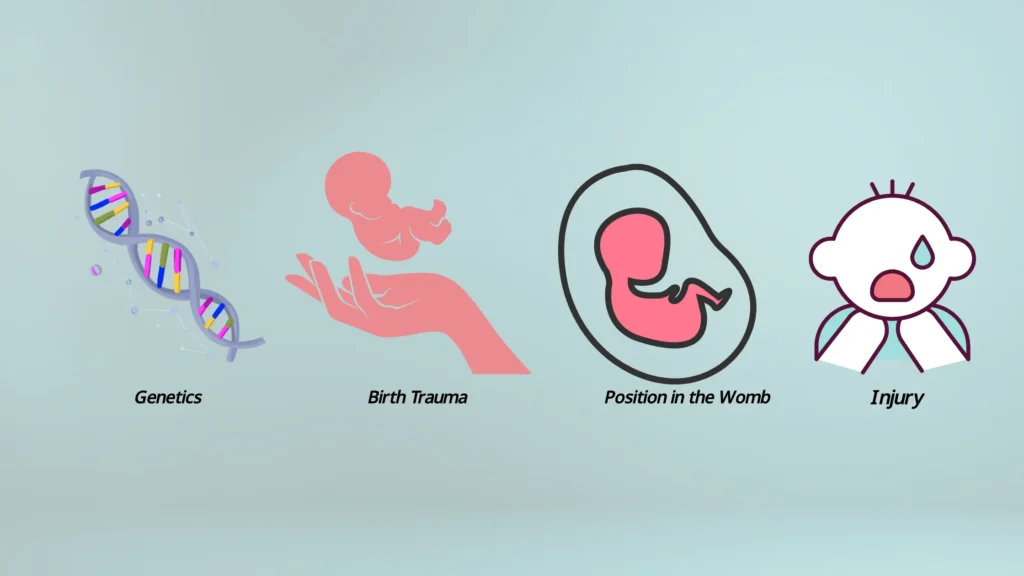
Nose defects in babies can be congenital or acquired. Congenital defects are present at birth, while acquired defects develop due to external factors.
Genetics
Genetic factors are often the primary cause of different nose shapes. For example, if parents or grandparents had a Roman nose shape, the baby may inherit that characteristic. These traits influence the shape and structure of the nasal passages, including the bridge, tip, and nostrils. A baby’s nose shape is often a family trait and may resemble a distant relative.
Birth Trauma
In some cases, babies can experience mild trauma during delivery, leading to temporary changes in their nose shape. This can include slight swelling or bruising, especially if the baby passes through the birth canal in a difficult position. These changes are often minor, but can cause deformities like a flattened nose or minor asymmetry. Fortunately, these birth-related changes resolve as the baby’s body heals.
Position in the Womb
The development of a baby’s nose can be influenced by their position in the womb. A flattened or irregular nose shape may result from pressure on the face caused by a breech baby. Long stretches of time spent in one position can compress soft tissues, which can temporarily alter the nose’s appearance. As the baby gets older, this usually fixes itself.
Injury
A fall or bump to the face in early infancy are examples of external injuries that can harm the nose and change its shape. Bruising, swelling, or nasal structural misalignment can result from even small injuries. Any damage to the nose shape may go away on its own as the baby’s face develops, but in certain situations, medical intervention may be required to avoid long-term problems.
How to Correct Nose Defects in Babies
Although many baby nose shapes are perfectly normal and will change on their own as they grow, there are some situations in which corrective action is required. If you think your baby’s nose shape could be the result of an injury or defect, you should definitely see a medical professional.
Non-Invasive Solutions
In most cases, nose shape issues in babies will resolve on their own as they grow. If there is a minor defect, such as a slightly snub nose shape or a slight asymmetry, time may be the best solution. Many of these small abnormalities will go away on their own as the baby’s facial structure develops.
Medical Treatment for Severe Deformities
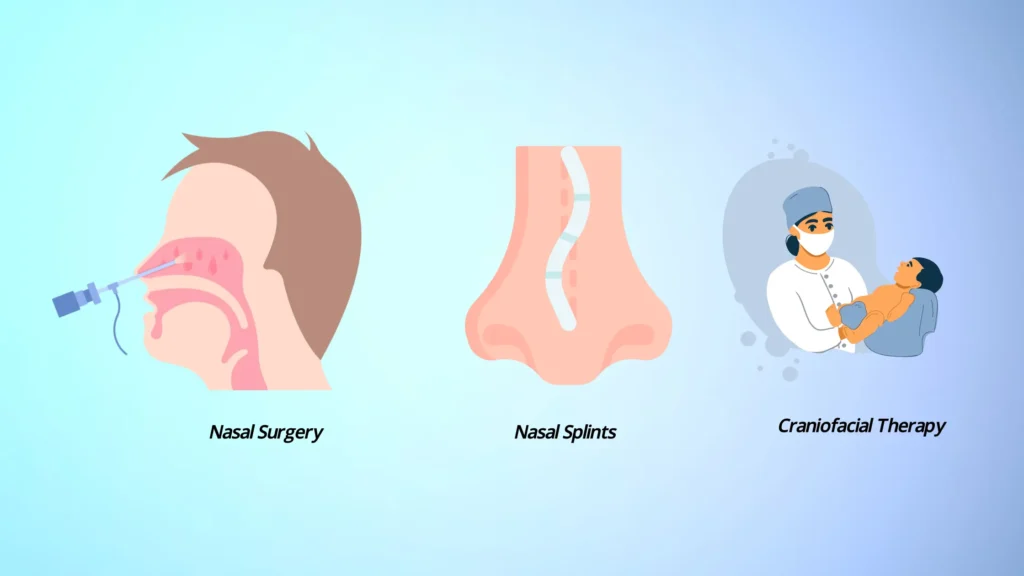
More serious flaws occasionally call for medical treatment. Among these treatments are:
Nasal Surgery
A pediatric plastic surgeon might suggest a minor surgical procedure to address breathing issues or cases where the nose shape is noticeably abnormal. This surgery may involve correcting deformities like a crooked nose, a deviated septum, or asymmetry in order to restore the baby’s function and appearance. The procedure is carried out under general anesthesia, and post-operative care is required to ensure proper healing.
Nasal Splints
As the baby’s facial structure develops, doctors may advise using nasal splints to gently reshape the nose in cases of injuries or minor deformities. As the baby’s nasal passages develop, these splints provide mild pressure and avoid misalignment. They ensure proper development without the need for surgery for babies with mild birth deformities or minor nasal injuries.
Craniofacial Therapy
For babies born with congenital defects affecting their nasal passages, craniofacial therapy may be needed to address the underlying condition and improve functionality. In order to help shape the facial structure, this specialized therapy may involve physical techniques, exercises, and external devices such as molds or helmets. By promoting bone growth, improving nasal function, and maintaining health, craniofacial therapy aids in the baby’s development.
FAQ Section: Everything Parents Need to Know About Nose Shapes in Babies
1. What is the most common nose shape in babies?
The button nose shape is one of the most common and cutest nose shapes in babies, characterized by a small, round tip that is slightly upturned.
2. Can a snub nose shape be corrected?
Medical intervention may be necessary if a congenital condition or injury is the cause of a snub nose shape. But usually, this shape is normal and goes away with time.
3. How do I know if my baby’s nose shape is normal?
If your baby’s nose shape appears symmetrical and they are able to breathe comfortably, it is likely normal. However, if you notice irregularities or breathing difficulties, it’s a good idea to consult a pediatrician.
4. Can a Roman nose shape be inherited?
Yes, a Roman nose shape can be passed down from parents or grandparents. It is typically a genetic trait and is not necessarily a defect.
5. Is surgery necessary for nose shape defects in babies?
Surgery is only necessary for severe deformities that affect a baby’s breathing or cause significant disfigurement. Most minor nose shapes correct themselves as the baby grows.
Conclusion: Nose Shapes
Baby nose shapes are different. It is important to remember that all of your baby’s differences make him/her unique in all their beauty, whether they are born with a button nose shape, a snub nose shape, or even a seemingly more prominent Roman nose shape. Nose shapes will further develop in their most perfect form, but some may need correction. Always consult a medical advisor when you feel that your baby has a problem with his or her nose shape.
Explore more on Pregnancy Must –
